[Jim Rizoli, in Oct 2015, interviewed the now late Professor Robert Faurisson. Prof Faurisson, one of the “fathers” of “Holocaust” Revisionism passed away on Oct 22, 2018, aged 89.
— KATANA.]
_______________________
Jim Rizoli
Interviews
Prof Robert Faurisson
Oct, 2015
Click the link below to view the video on YouTube (may not be available in some locations):
https://www.youtube.com/watch?v=mqRLnpJ_8ek&t=1838s
Also here on Bitchute:
https://www.bitchute.com/video/FbVcINOtox9k/
YouTube Description
Extraordinary Revisionists
Certain features have been disabled for this video
In response to user reports, we have disabled some features, such as comments, sharing, and suggested videos, because this video contains content that may be inappropriate or offensive to some audiences.
Jim Rizoli, Robert Professor Faurisson interview.
Published on Nov 9, 2015
__________________________
TRANSCRIPT
(114:46)
[00:00]
[Intro song] No one knows what it’s like to be a bad man, feel the sadness, behind the light, …
[00:33]
Jim: It’s a pleasure to meet you! I’ve seen a lot of your videos. I read your information, and I’m just amazed to see what you’ve been through. And I have a lot of questions for you. And I would like to ask you all these questions I have laid out for me. And the first question I’d like to ask you is, I would think anyway that you are the “patriarch” of the revisionist movement! Wouldn’t you say that?
Prof Faurisson: Yes, with brothers, my friends.
Jim: Okay. [chuckling] All right. First of all, where were you born?
Prof Faurisson: So, I was born in England, near London, in a place called Shepperton.
Jim: OK. All right.
Prof Faurisson: I was born to a Scottish mother and a need a French father.
Jim: All right.
Prof Faurisson: My father was working in a shipping company, in Fenchurch street, London. Excuse me?
Jim: What year? The year you were born?
Prof Faurisson: Oh, 1929. After Jesus Christ!
Jim: [laughing] OK! So you didn’t know Jesus?
Prof Faurisson: I’m nearly 87.
Jim: 87! Oh, okay, very good! All right. Well, you are getting up there. That’s good! Where did you go to school?
Prof Faurisson: At the beginning it was in Singapore, in an English school. A beautiful English school! I think it was 1934, ’35.
Jim: OK.
Prof Faurisson: Then in Japan, in Kobe in an American school. And then I came back to France. And my mates would mock me because of my English accent! Our shores. So I decided not to speak English any more!
Jim: Okay.
Prof Faurisson: And that’s why I have to ask you to pardon me my poor and broken English.
Jim: I think you speak just fine! You speak better than half the people in my country. [laughing]
Prof Faurisson: Oh really!
Jim: Yeah! We have are some problems with people speaking English in my country!
Prof Faurisson: I understand.
Jim: Let me ask you this, about your education. Can you tell us about your education?
Prof Faurisson: So my education was really in France and only in Catholic schools.
Jim: Okay.
Prof Faurisson: And I have to say something which is perhaps sad for you. I don’t know. It happens that I am in [word unclear] but I’ve always been in Catholic schools.
Jim: OK.
Prof Faurisson: And especially in a Jesuit school in [word unclear].
Jim: Okay, all right.
Prof Faurisson: And then I was also in a Catholic school, a very famous one in Paris, called College [word unclear].
Jim: Okay. Very good.
The big question here is, how did the “Holocaust” issue come into play with you? When did you start, or how did you start getting interested in that issue?
[04:15]
Prof Faurisson: I’m going to be perhaps a little bit long. Excuse me.
Jim: That’s fine! You can talk as long as you want. My cameras are working, everything’s fine, so I might just move this down just a little bit, but that’s fine. All right. So you can tell us exactly, all about your “Holocaust” issue days. How’s that?
Prof Faurisson: Yes. So during the war itself I was totally anti-German. And I had a little trouble, because of that. In 1939 I was ten. In 1945, end of the war, I was sixteen. Now I’m going to tell you something which happened in 1942. In 1942 Pierre Laval*, he was the Prime Minister of Marshall Petain.
[* Pierre Jean-Marie Laval (28 June 1883 – 15 October 1945) was a French politician. During the time of the Third Republic, he served as Prime Minister of France from 27 January 1931 to 20 February 1932, and a second time from 7 June 1935 to 24 January 1936.
Laval began his career as a socialist, but over time drifted far to the right. Following France’s defeat and armistice with Germany in 1940, he served in prominent roles in Philippe Pétain’s Vichy Regime, first as the vice-president of the Council of Ministers from 11 July 1940 to 13 December 1940, and later as the head of government from 18 April 1942 to 20 August 1944.
After the liberation of France in 1944, Laval was arrested by the French government under General Charles de Gaulle. In what was widely regarded as a flawed trial, Laval was found guilty of high treason, and after a thwarted suicide attempt, he was executed by firing squad. His manifold political activities left a complicated and controversial legacy, resulting in more than a dozen conflicting biographies of him. SOURCE: Wikpedia]
And he said in a speech. He said:
“I hope that Germany will win this war!”
And he added:
“Because otherwise it would be the victory of communism in Europe!”
And I was incensed, because he had said that he wished the victory of Germany. Because, myself, I was hoping the victory of the French, the Gaulists, the English, Churchill. Of the Americans, of course, and I have to add, it’s very important, I wished the victory of Stalin!
It happens that by being on the side of the Americans, I was also on the side of the Soviets! And remember, it was in a Jesuit college that the priest came into place where I had written on my pulpit, “Mo a Laval” [sp] which means “Death to Laval”. And he mocked me and he said, in front of my mates. He said, … I’m going to say it in French first. Okay?
“Oh fo Faurrisson [word unclear]”.
“Oh you Faurrisson! With your English people who are running like rabbits in the desert!”
It was because the English in Tobruk, Benghazi and places like that were having a difficult time with the German troops of Rommel. Okay, so I was on the side of those people.
And one day, exactly on the 8th of May 1945 which was the capitulation of Germany, if you remember.
My father entered my room, my bedroom, that I shared with my brother Phillipe, and he said in French. He said:
“Robert, es-tu heureux?”
“Robert, are you happy?”
And I remember that I was a little bit embarrassed by that question. And I said:
“Yes.”
But, suddenly, I don’t know why, I thought for the German people, for the German soldiers. And I thought to myself.
“Now that they are vanquished. They have been fighting so hard, I have to respect the vanquished. I am on the side of the victor. I have to respect those people. And I’m going to protect them! And I want to understand what really happened.”
Do you understand that?
Jim: Yeah! Yeah, no, I understand.
Prof Faurisson: And I decided in a way to be like a referee, trying to see what really happened. And I didn’t want to be any more, anti-German, or pro-Stalin, and so on.
And I can say that this very day, I was 16, I decided to revise history! Which means to have a second look, a third one, and so on. And to check and to double check and to be “fair”!
Do, you know, that “fair”, we cannot translate it into French. It’s so typically British, “fair”. Try to be fair with the vanquished!
So, I remember that in college [word unclear] where I was, many of my mates didn’t understand my opinion about all this. And some of them thought that I was a “Nazi”! I was absolutely not a “Nazi”! [laughing] I wanted to understand, that is all!
And it happens that I read a book by a man called Paul Rassinier. And Paul Rassinier wrote a book called, the title is extraordinary, “The Lies of Ulysses”. Ulysses, of course, Homer. A story told by Homer. Ulysses, you see, was among the victors. When he came back home, a long time after, he told plenty of stories about his experience of war.
And, especially about his sufferings He had, really, let’s say hundreds of sufferings, that he told the people a [word unclear] of stories about his sufferings. It’s normal in a way, it’s human.
So, Paul Rassinier himself, had been a Resistance [a member of the French Resistance] and he had been in two German concentration camps.
And when he heard the stories about gas chambers, and so on, he said:
“Oh! This is strange! Because in the camp where I was, there was no question of gas chambers. I am going to see, how is it that so many people are talking about gas chambers in Buchenwald and Mittelbau-Dora.”
And then, he checked, he tried to check for Auschwitz and other camps. And he was very surprised to see that we had only “testimonies”! No proof. No real proof was brought, like in a criminal case.
Let’s suppose that there is next to the place you are yourself, a crime. Automatically the judge, a magistrate will decide that there will be a forensic report. He will never say:
“Oh, I have so many witnesses that I don’t need such a report.”
No! He needs a report. And sir, I can tell you sound thing extraordinary.
Since 70 years, we had only one! One forensic report. We needed that. Thanks to a forensic report, you can see what was a “gas chamber”, how it functions, what was the place of the crime. What was the weapon of the crime, an extraordinary one!
And we don’t have that! We and only one report, it was a French one about a camp in France called Struthof*, near Strasbourg.
[* Natzweiler-Struthof was a German-run concentration camp located in the Vosges Mountains close to the Alsatian village of Natzwiller (German Natzweiler) in France, and the town of Schirmeck, about 50 km (31 m) south west of the city of Strasbourg.]
And the forensic report was done but Dean of the Faculty of Pharmacy, in Paris. And we know the result. The report disappeared!
That we know, thanks to three other doctors, we know what were the conclusions of Struthof. The conclusion was:
“No hydrocyanic acid.”
Because Zyklon B is hydrocyanic acid. None in the so-called “gas chambers”. None in the chimney! And none in the bodies of 86 jews, supposed to have been gassed!
Jim: Now where is that report today? Who has that report?
Prof Faurisson: The report should have been, should be today, but I’ve been and I’ve checked, and there is no report in a place called Meaux, a place for the [word unclear] You see? Where they have all those documents. And considering the results of Professor Rene Farbe, nobody else decided in 70 years to have a forensic report! Because they knew that it would be too dangerous.
Jim: Right.
Prof Faurisson: And I think that very few people know that, because they think that we have witnesses, so we don’t need anything else!
Jim: Right!
Prof Faurisson: No! We need first a forensic report.
Jim: Now, let me let me get into your situation with the Zundel Trial. How did you get involved with Zundel Trial and all that? What happened there?
Prof Faurisson: Yes. I met Ernst Zundel, who is an extraordinary man! An exceptional man! I think in 1979, in Los Angeles. Because in Los Angeles, for the first conference of historical revisionist organization. I mean, myself a conference.
See: The World’s First Anti-Holocaust Convention — Instauration Dec, 1979
And I remember a lady saying:
“Oh, this is dynamite!”
I am going to tell you why dynamite. I go back to Zundel. I will certainly not forget him!
I had been in Auschwitz in 1975. I am going to give you an idea of the way I made my investigations.
I saw, what is called “Crematoria I” with the supposed gas chamber to kill people. Immediately I saw that it was not, certainly not a gas chamber! Because you had a tiny little door with partly a glass. And the door would open on this side, so that the corpses, cadavers would have been there blocking the door.
Jim: So it opened inwards, it opened inwards, right?
Prof Faurisson: Yeah. And you see with the glass [the glass window in the door] you do this with your elbow. And hydrocyanic acid, you know what? It goes at twenty metres from there to the SS [word unclear]
Jim: Right.
Prof Faurisson: So, it’s a totally impossible! But investigate, follow me there. I went to the Museum of Auschwitz, and I said to the people. There I am.
“I am a professor in Sorbonne, I am interested in Auschwitz, and I want someone of you people to help me in my investigation. But I want the top of the top of you people!”
And they said “okay”, and a man came. His name Marshar Wick [sp].
And we had a conversation in German. I said.
“Are you ready to help me?”
And he said:
“Jawohl!”
And he would always say “Jawohl!” [chuckling], except once where he said “Ja!”. So watch for this, which is coming.
And I said:
“Ich habe ein Problem!”
“I have a problem! Come with me!”
And I brought him to a place right in front of the Krema I (Crematoria I), which had on one side a supposed gas chamber. On the other side the place of the furnaces, for the cremation.
And the door, another door, not the little one before. The door was open and everyone could see an oven, a furnace. So, from where we were, I told them only, I asked him a question only, with one German word.
I said:
“Echt?”
Which means, “authentic?”
And he said:
“Jawohl!”
I said:
“Come with me.”
He came with me. I put my finger on the opening, and I showed him that there was no, I think you say “soot”?
Jim: Yeah. Soot.
Prof Faurisson: And then the man suddenly, his face changed. And he said:
“Rekonstruiert.”
Which means, “reconstructed”.
Jim: Right.
Prof Faurisson: Now wait a minute. A reconstruction doesn’t mean that with have a lie there. Because it could be fair, it could be honest. But it could also be not fair and not honest. And I had an idea. You need to have ideas! And to express them right, you see.
I said suddenly, looking at his face, I said:
“Also hast du Pläne?”
Which means, “Therefore, you have plans?” And he said:
“Ja.”
Jim: Yeah [chuckling].
Prof Faurisson: And I said:
“Wo sind die Pläne?”
“Where are the plans?”
And he said:
“You would have to go and see Mr Iwaszko. The [person] responsible for the archives.”
But the next day I had to go back to France. So I came back in March, 1976.
And this is what I have been on the 19th of March, 1976. I went to see Mr Iwaszko. I brought in a bottle of alcohol. He didn’t say anything. He [word unclear] me, nothing. I said:
“I’ve seen Mr Marshar Wick, and I want to see the plans.”
Of those supposed gas chambers. Because not only in Crematoria I, Crematoria II, III, IV and V. I want to see them. He showed me a big table. Okay, I sat down and I wait. And the man brought me documents and documents of the trial of the poor Rudolf Hoess, who had been one of the three successive commandants of Auschwitz. And, it was about the trial, and it was all in Polish! I said:
“Oh! Bad luck for me. I don’t understand Polish at all.”
And so by looking, and looking over, I saw little, tiny little photos, with captions in German. And I understood the plans, of all those places! And I paid in zloty [Polish currency]. I paid for 116 photos. I came back to France. I was very pleased! But I had to wait and wait, and wait, to have the photos.
Anyway, to make it short, I didn’t know where I could publish! The internet did not exist. It was impossible! I knew that it was dynamite! What could I do? And finally, a friend of mine told me:
“I know a Spanish journalist. He could come and perhaps publish your stuff.”
The journalist came with someone helping him, okay.
And I said:
“You see, you can take photos, but I don’t want any photo of me. I don’t want my face in your magazine!”
He said:
“Yes.”
And so on, and went away. And a few months after, I discovered the magazine with a title, with of course, my face! And the title:
“Defense Lawyer of Hitler!”
I was the “defense lawyer of Hitler”! And the troubles began at that time. And I worked very, very [word unclear] very, very long time in a place called “Centre de documentation Juive Contemporaine”, “Contemporary Jewish Documentation Center”* Okay, it’s in Paris.
[The Centre de documentation Juive Contemporaine (CDJC, Contemporary Jewish Documentation Center) was clandestinely created in France to document the persecution of the country’s Jews during the Second World War. It is a key component of the Shoah Memorial.
The CDJC — Centre de documentation juive contemporaine, or Contemporary Jewish Documentation Center — was the seed from which the Shoah Memorial eventually grew. Its founders’ determination to document the genocide of Europe’s Jews during the war is still one of the main missions of the Shoah Memorial, a museum, documentation center and memorial at the same time.
The foundation of the CDJC dates back to April 28, 1943, when industrialist Isaac Schneersohn clandestinely brought together around 40 Jewish activists and community leaders in his Grenoble apartment to discuss the idea of creating an archive.
The goal was to set up an organization that would collect evidence on the persecution of the Jews in order to bear witness and demand justice after the war. A few years later, they achieved their aim when Nuremberg trial prosecutors relied on documents from the CDJC archives. Source: Http://www.memorialdelashoah.org/en/archives-and-documentation/the-documentation-center/the-history-of-the-cdjc.html]
And this is, I want to tell you, that I said when I entered the place for the first time, I said to the man:
“I want a photo of a gas chamber.”
And the answer of the man, was:
“We have many testimonies! We have many books.”
I said:
“A photo!”
And he said something else, like that. And I said:
“A photo!”
And he said:
“Sit down!”
And for 60 minutes I waited for a lady who was going everywhere trying to, find a plan, not a plan, excuse me, a photo of a gas chamber. And there were no photo, at all. Because he felt that I knew something about the topic, and [chuckling] it was dangerous for them.
Jim: Right.
[28:29]
Prof Faurisson: And, you see, I worked very much and I decided to the United States for our conference, where I met Zundel. And so I am coming back to Zundel.
My English being so bad, I decided to find someone to read the paper of my conference. And this man was Ernst Zundel! And, it was in Los Angeles in 1979. And I came back very often to the United States, because what I wanted to see was an American gas chamber.
You see, an American gas chamber — I visited one in Baltimore [word unclear] An American gas chamber, is, was, because they are no more, was functioning with hydrocyanic acid.
And what I saw was something extraordinary! To kill only one man, it was in iron [the construction of the chamber]. It was thick like that. The windows were something called “aircrete”, which means “very strong”.
And there was a pier in the center. Why a pier? And I’m going to give you immediately the answer. It’s rather easy to kill someone with hydrocyanic acid. But the question is, how can I kill someone without killing myself?
Jim: Right!
Prof Faurisson: How can I enter a place, where I have the corpse of someone which has so much hydrocyanic acid, because hydrocyanic acid penetrates everywhere!
You see, it’s fantastic how it penetrates! And stays there. And you cannot touch it. So how could medical doctor and two people helping him, how could they get into the place? So, I have know time to explain will try to explain that. It’s [word unclear].
Jim: So the so whole point was, that you saw that the gas chamber, they say was a gas chamber at Auschwitz, the crematory I, the gas chamber combination. You saw that there was no way they could gas anybody in a building like that. And when you came here to the United States, you saw a real gas chamber and now you can see, well this is the way you do it. The way they had it, you could not do it.
Prof Faurisson: Exactly.
Jim: Right, okay.
Prof Faurisson: And you see it was a terrible thing, because as soon as did this, I got into real problems. And my wife, and my children, and now some of my grandchildren. You have to be ready for that, okay?
Jim: Well tell tell us what, …
Prof Faurisson: I have to say something about American gas chambers.
Jim: Okay, go ahead.
Prof Faurisson: How is it. In this gas chamber you had [word unclear] which move, you see.
Jim: Right.
Prof Faurisson: To get after the killing of the man, to get all the gas you have something on the top for aspiration [extraction] of the poison. And the poison gets into, in French what we call [word unclear], which is a place where you neutralize hydrocyanic acid. Okay? And the stuff which is supposed to be neutralized is sent into pipe and then into a chimney. The chimney must be higher than all the penitentiary.
Jim: Right.
Prof Faurisson: And the day of an execution, the guards have no right to be on the top [guard towers]. It’s so dangerous, you see.
And when you see that I would say it’s finished! You understand that it’s finished! Now what about the pillar, the central pillar. This is the explanation. The people are so afraid that the hydrocyanic acid could get outside, could [word unclear] everything for the installation, you see, that they try to make a depression [a lower pressure that outside the chamber]. A depression, you understand? Okay. If you make a depression all this could crumble [collapse] so you had to put a pillar to make it strong.
Jim: Okay.
Prof Faurisson: Something else. Very important. Hydrocyanic acid is explosive! The Germans, … I have found documents and documents about all that. They talk about “Explosionsgefahr”, “danger of explosion”.
And, do you know why the man that you are going to kill is, how do you say “ligoté”, which is “strapped”, …
Jim: Strapped, yeah.
Prof Faurisson: Very strongly! Why? It’s because if this man gets loose, he might create static electricity.
Jim: Sparks. Right.
Prof Faurisson: And you would have an explosion.
Jim: Yep.
Prof Faurisson: But I remember when I visited [chuckling] this gas chamber in Baltimore, I had an explanation, not only from the director, but even from inmates helping the gassing procedure, and so on. And they said that the day you have an execution, or an exercise also, everybody is afraid. Everyone could be poisoned, or gassed, or killed, and so on.
Jim: Right.
Prof Faurisson: And we have this silly story of the confession of Hoess. And how did they get this confession? So, I made a discovery about that. Do, you know, that I could make you confess to whatever I wanted?
Jim: Yep.
Prof Faurisson: And you could get me confessing whatever you want, without touching. Nothing! There is a way, a fantastic way! You forbid the man to sleep. One day is possible, two days, …
Jim: Oh, I see what you are saying. You are saying you have it so he doesn’t sleep, he stays up all the time?
Prof Faurisson: He cannot sleep.
Jim: Oh okay. Yeah. Deprive him of sleep.
Prof Faurisson: Yes. You don’t even need to touch the man, you need to make noise, and so on. Because those dirty people, they confessed in a book how they did manage to get those confessions. And said that with a stick when he was like that, they would waken the poor man.
Jim: Yeah.
Prof Faurisson: And the stupidity of the story. Hoess confessed that when the people inside the gas chamber stopped screaming, they understood that they were dead. So, they put a ventilation, they push a button for a, how do you say, “ventilation”, …
Jim: A fan, a ventilation fan.
Prof Faurisson: A fan. And immediately they would get into the place. And “immediately” is the German word, “sofort”. It’s a terrible word. Immediately they would enter the place, eating and smoking! Which means without even a gas mask!
Jim: Right! Makes no sense.
Prof Faurisson: And smoking, you could have an explosion.
Jim: Yeah, right.
Prof Faurisson: You see, so those confessions are nothing!
Jim: Right.
Prof Faurisson: They are lies only!
Jim: Now he said 2 1/2 million people were killed that way, didn’t he? Didn’t he say, 2 1/2 million?
Prof Faurisson: Yes, different figures. They got different figures from him. As, you know, about the figures it’s a fantastic story. So if you are very careful and if you want to see the figures given only for Auschwitz and Birkenau, it begins at 9 million!
Jim: Oh! Wow!
Prof Faurisson: Yes. Then you have 8, 7, I don’t remember if you have 6.
Jim: Right.
Prof Faurisson: But what we got for a very long time, was four million.
Jim: Right.
Prof Faurisson: And suddenly in 1990 they decided to destroy this monument [plaque] with four million killed.
And then they put one million and a half! Suddenly. And then the historians got down one million, then you had someone like Pressac, a friend of the Klarsfelds, who said 700,000, and then you had a man giving 510,000. Nothing you see. There’s no sense.
Jim: How many do you think died, in the camps. Can you explain that to us? What do you think are the real figures?
Prof Faurisson: I cannot answer your questions, Sir.
Jim: Okay.
Prof Faurisson: And I’m going to tell you why. It’s because I would need to go into a place called [word unclear] where you have many many documents. And I cannot go to this place. It’s impossible. It would be forbidden.
Jim: Okay.
Prof Faurisson: Now do you want me to tell you the reactions in France first, and then in the world, about my discoveries?
Jim: Sure! Yeah. Go ahead.
Prof Faurisson: Yeah, okay. So all this I put in a long paper. The title is “The Victories of Revisionism”.
And it was published on the internet on December 11, 2006. And I gave all sorts of reactions of the people who were against us. And it’s extraordinary the admission. Yes, extraordinary! I must say that in 78 [1978] I was attacked, physically attacked!
Jim: Where did that happen when you were attacked?
Prof Faurisson: Oh, I was attacked ten times! So the first part is important. Two in Lyon where I was a professor at the University of Lyon. Two in Vichy where I live. Four in Paris.
Jim: Wow!
Prof Faurisson: And two in Stockholm. In Stockholm I ran away so quickly that they were not even able to catch me!
Jim: Wow!
Prof Faurisson: Surprisingly, we have this on camera. You could check it.
Jim: Okay. Wow!
Prof Faurisson: So, I was attacked, especially one day in Vichy. They nearly killed me!
Jim: Yeah, wow!
Prof Faurisson: I was saved by a young man. I didn’t know this man. He was a fisherman. He was a student I was told. And he was nearly one meter ninety [190 cm/6’ 3” tall]. And the day after the attack, he saw my name in the newspaper and he said to the police, that he regretted to have saved my life! [chuckling]
Jim: Oh! Wow!
Prof Faurisson: And so, the newspaper, the most important in France, is Le Monde. And they had to publish something, they had to say a professor has been attacked! They tried to not say why.
Jim: Wow.
Prof Faurisson: So, we have in France what we call, the “right to reply”. But it is a very difficult one to angle. In answer I said:
“Why don’t you say to people why I was attacked?”
And I said:
“For years and years I’ve been sending you papers about the problem of the gas chambers. How is it that you don’t publish it. You should do it”.
Jim: Yeah.
Prof Faurisson: And so, they were obliged to publish it, and it was a terrible hullaballoo!
Jim: Wow! What year was that? What year did you publish that?
Prof Faurisson: I published that, … Oh! Good question. I published that in Lavetour [sp].
[45:00]
People of the extreme Left. They published my stuff. So the question was, I said very simple:
“Show me, or draw me a Nazi gas chamber!”
Jim: Right.
Prof Faurisson: Why did I say, “or draw me”? Because some people might say:
“We cannot show you something that the Germans have destroyed.”
Jim: Right.
Prof Faurisson: So I say okay, okay, so show me what the Germans have destroyed! I want to see.
And can you imagine the number of articles, of things like that, which appeared at that time. It was seventy eight, seventy nine.
Jim: Okay. Now let me ask your question. When you published this information, did that affect your job as a professor!
Prof Faurisson: Oh! It was finished for me!
Jim: Wow!
Prof Faurisson: It was a disaster!
Jim: Did they fire you?
Prof Faurisson: My specialty I must say, the university, one of my two specialties was appraisal of texts and documents, literature, history major. You see it was my specialty.
I would train my students to look at a documentary. Very short. Three times. Once with the sound. They without the sound. And then again, with the sound.
And they were so surprised, to see for example, they show you in those films, they show you cadavers, corpses. And they talk about people being killed! So you think you are seeing people who have been killed! But they are in the same shape, all of them. You could see that they died from typhus.
Jim: Right. Sure. Natural causes, or diseases. Yeah, I get you.
Prof Faurisson: And you have to story, very interesting of Bergen-Belsen. Bergen-Belsen was a camp on the west, and the British were coming next to Bergen-Belsen. Where it was a disaster. Because of the bombings. Because no more Zyklon B as pesticide. Nothing to eat and even no more water. It was a disaster!
So the Germans decided something very strange. Not well known. They decided to go with a White flag to the troops of Montgomery, and say:
“Now be careful. You are approaching a place where you have typhus and so on. Don’t liberate the prisoners! It could be a disaster even for your troops.
Jim: Right.
Prof Faurisson: For us, for the civilians, and so on. And the British decided to collaborate with the Germans!
And they went to this camp, and this camp, it was a very sandy place. Sand, Sand. So they could put the bodies in the sand. Do you understand?
Jim: Yeah.
Prof Faurisson: And they wanted to know how many people had been buried like that. And they decided to make six big places to put back the bodies once they have a figure, a number. OK? So they took out the bodies, they counted them and a bulldozer pushed to the place where German woman of the Army were obliged with naked hands to throw the bodies into the new place.
And the bulldozer, you see it so quickly, that most of the people think it’s a German bulldozer, with a German driver. That it was a kind of industry to kill the people every day!
And to make it more possible to believe in that, you had even pictures with the driver, you cannot see his head! You cannot see it is a Tommy [British soldier]. That it is a British driver. People think it was a German industry!
Jim: Right.
[50:52]
Prof Faurisson: Because you must know something. All this topic about, how do you say that, those things and so on, had already been used during WWI! French and English propaganda would say that the Germans were an English [word unclear] of terrorists, or [word unclear] like that. Fabricating terrors and so on.
So the same story was taken for WWII, but they added “gas”.
Jim: Right.
Prof Faurisson: Gas, when it was, be careful, when it was American, or Western propaganda. But for the Russians, nobody knows that. I described that. Let me tell you this. The Soviets liberated Auschwitz on January 27, 1945. So I had the idea to get someone to go and see the Pravda. “Pravda” means “truth”. The newspaper, the communist newspaper. And I said:
“You begin please on the 28th of January and see when they are going to talk about Auschwitz. On the 28th nothing! 29, nothing! 30, nothing. 31, nothing. First of February, a little thing. And then suddenly on the second of February the biggest discovery of the Soviets! Did, you know how, according to the Soviets, the people were killed in Auschwitz?
Jim: No.
Prof Faurisson: You cannot imagine. They were killed by electricity!
Jim: Oh, okay. I got it. Yeah.
Prof Faurisson: And the bodies were full on something, which would bring them to a big furnace and so on.
Jim: So that was the first lie. The big lie.
Prof Faurisson: Yes. So you had gas, then electricity!
Jim: [chuckling]
Prof Faurisson: Wait a minute. You had steam! Which is the case for Treblinka. Treblinka, you had a document called “PS3311”. And this document is about Polish testimony about what happened in Treblinka. In Treblinka, in this document. And this document, be careful, had automatically the value of a proof, according to the charter of the International Military Tribunal, Article 21. Every Article of that kind had not to be proofed. It was the “truth”. Fantastic!
It’s thanks to that, that the Nuremberg Tribunal said that Katyn [Katyn Forest mass murder of Polish officers, etc., ] was made by the Germans! Everybody know that it was done by the Russians, of course.
And about Treblinka they said in detail that those poor Jews were killed in steam chambers. There was a well, there was a pipe, there was a boiler, and there was a chamber, very slippery! The Jews would fall down you see! [laughing] A silly story!
Jim: Right, right.
Prof Faurisson: You have only silly stories.
[55:28]
Jim: Now have you been to Treblinka?
Prof Faurisson: Yes! I’ve been to Treblinka. Good question! You are going to see why. Did you know the there is a film by Claude Lanzmann, called “Shoah”? Do you know that?
Jim: The “Shoah”?
Prof Faurisson: “Shoah”, means the “Holocaust”.
Jim: Yeah.
Prof Faurisson: “Shoah”. Nine hours and 25 minutes.
Jim: Wow!
Prof Faurisson: I’ve taken notes during all that time. And there is especially Treblinka. And in Treblinka he would explain you this. That the Jews of Warsaw were brought to Treblinka. Treblinka, a place where they were immediately gassed! All of them!
And Lazmann filmed a man supposed to have been a witness. He was a locomotive driver. He was the man who would every day bring, like that, the Jews to their death in Treblinka! With gas. No more “steam”. And you could see this man, he was a very important witness of “Shoah”. Other witnesses also, but this on the locomotive driver.
Sir! I went to Treblinka and near Treblinka I found the locomotive driver. And we made a film about all this. A part of what he told us. And he was speaking about this. And suddenly I asked him a question. I said:
“So, everyday you were yourself were bringing Jews like that to their death!”
And he said:
“No!”
“How can you say no?”
“No!”
“But when did you know that they were killed?”
“Oh”, he said. “After the war.”
This is the big witness.
Jim: Yeah. Wow!
Prof Faurisson: And I found in Treblinka a very interesting man, a peasant. And I wrote many things about this, and I took dimensions of the place and so on. And you could see that it was an impossible story!
Jim: Sure. Oh yeah.
Prof Faurisson: And I wrote about that.
Jim: Well they say, what 800 – 950, 000 people were killed there, right?
Prof Faurisson: There are always different figures.
Jim: I know, I know it.
Prof Faurisson: Which is normal in a way. Okay.
Jim: And there is nothing at Treblinka now. There is nothing there! I mean, …
Prof Faurisson: There is nothing there! [chuckling] You see, did you hear anything about a priest called Patrick Desbois? He wrote a book called, “Shoah by Shooting”* or something. [“The Holocaust by Bullets“] I’m not able to put it into English. “La Shoah par balles”. Okay. And this man was a priest, decided one day to make an investigation like that, about those poor Jews killed in Ukraine, especially. And he told us:
“I have found many, many pits.”
And he said:
“Eight hundred of them, and the total of the dead was one million and a half.”
Oh! Sir. This is a joke! A total joke! A shameful one! This priest tells us that first he visited a rabbi in England. And the rabbi said:
“You must not trouble the dead! Don’t open whatever. Because they are saints!”
The Hebrew word was “sekiden” [sp]. They are sacred, don’t touch them. So [chuckling] this Patrick Desbois goes from one village to another and he asks all people to come and he shows you a field or a forest, or whatever. And people are like that you see. [motioning to indicate tears coming down his face] They are crying. And they say:
“Yes, in this place so many people, so many Jews were killed!”
And that is it. You cannot see even one corpse!
Jim: I know! I know!
[* See: Patrick Desbois and the “Mass Graves” of Jews in Ukraine by Carlo Mattogno.]
[61:55]
Jim: Let me ask you about your situation now the Zundel Trial, and how you came and in contact, and all that with Fred Leuchter? How did that come about?
Prof Faurisson: Yes. So I came to help Zundel in 1985, 1988, 1992. Okay. He is really a friend. And I decided to help him. So, I came to Toronto even in 1984, 84, 85, and so on. And I came with 5 big trunks of documents.
Jim: Wow!
Prof Faurisson: Imagine that at the airport! [chuckling] Yes. And I was at Zundel’s house working day and night. And I attended, of course, those two trials. And I was admitted as an expert. You know that you have to ask to be an expert. And it was extraordinary! Because, to make it short I would say that in 85, we “killed” historian number one of the “Holocaust”, Raul Hilberg!
Jim: Yeah, Raul Hilberg.
Prof Faurisson: We “killed” also, I can’t remember his name, the witness number one. It’s not as interesting as that. And in 88, remember Fred Leuchter testified. So I’m going to talk about the first one, 85.
Jim: Okay. That is fine.
Prof Faurisson: We had this man. He came like this, very sure of himself, and it was a disaster! Raul Hilberg. Raul Hilberg had published a book in 1961, called “The Destruction of the European jews”. On page 177 he said there had been two orders from Hitler to kill the Jews! Oh! Two orders? Really?
And the first order was:
“Go and kill them where they are!”
Russia and so on. And the second one:
“Collect all those people and put them in places to kill them.”
And surprisingly there was no footnote! No text! Nothing!
Jim: Right.
Prof Faurisson: Coming out of the blue like that! Two affirmations. Usually Hilberg would always put footnotes. Be very precise. And there is nothing! Okay? And I was helping an extraordinary defense lawyer, Doug Christie.
Jim: Right. Doug Christie.
Prof Faurisson: And I used to work in the evening, during the night until 3, or for in the morning. And when he woke up he would find the question he had to put, and the documents. And he was there, a magnificent man, and I was on his side, on my chair. And I had little stickers, like that, yellow stickers. And every time I thought a question should be put — because it was long, you see. I would put a sticker on his desk. And you should have seen the face of Hilberg, with the yellow stickers! [making a face of shock and dread]
Jim: [chuckling].
Prof Faurisson: And I had the idea to ask Doug Christie to ask him a very simple question. Because I knew that this man was what I call, a “man of paper”! He was a professor of paper, and paper, and papers! And I said to Doug Christie:
“You are going to ask him which camps he visited. But don’t put the question like that. Give him a list of camps. Take Buchenwald. Did you visit this camp? How many times? And how much time every time?”
We started with Buchenwald, and he said:
“No.”
And the second one, he said:
“No.”
And the third one, he stopped us. And he said the had visited none!
Jim: Wow!
Prof Faurisson: Except! Except for a visit, a no official visit for his speech, or ceremony. So he was a man who had not even taken care to go and see where were this gas chambers! Even destroyed, because even destroyed it’s very important to see the dimensions, and so on.
And it was a total disaster, because we found something that he had said in 2000, wait a minute, yes the first one I said was in 1985. So in 1983, he had said somewhere, that finally there was no document, nothing. It was the German bureaucracy who had decided, suddenly, without any order whatsoever to kill the Jews! That to not write anything down, but to work by these, remember those words:
“By an incredible meeting of their minds! A consensus by mind reading!”
Jim: [chuckling] I know!
Prof Faurisson: I remember the day he said that. Once we were back at Zundel’s house there was the big table. And we were numerous. And I said:
“My friends! Do you know that today we are going to enter a new era! Because when I need a pot of coffee, or water, whatsoever, I will not even have to say, ‘I want coffee, or water’, because we are, all of us, to work by an incredible meeting of minds, consensus, mind reading!”
Jim: [laughing] Right! Right, telepathy!
Prof Faurisson: Now if it was incredible, sir, why should I believe? You say yourself that it was “incredible”! Okay? Now, how could we explain this change in Raul Hilberg?
I have an explanation. It’s because — we are going back to France — when there was this fantastic story everywhere, the Jews decided, some Jews decided to make a big international conference in Paris. In the Sorbonne, where I had been a professor. And to show the destruction of the European Jews, the “Holocaust”, the “Shoah“, and so on. And it lasted I think, four days, which is very much.
So I went to see the organizers of this conference. There were two of them. And I said:
“It’s against me. It’s against Faurisson! So I would like to attend this conference.”
And the first man said:
“No! No question!”
And I said:
“Even if I say that I will not talk? Say anything.”
“No! You cannot negotiate that!”
And to when I saw the second one, he told me exactly the same thing. So you see, you had a big international conference against me, and I had no right to go and attend this. And the only reaction of the professors was on the 21st of February 1979, when a journal, once more, they published something called “Une déclaration d’historiens”, “A Declaration of Historians”. There were 34 of them, French professors of history, and so on.
Let me find what they decided. It was in 79. If I can find it. Okay. Yes, there we are. Thirty four French historians, signed a lengthy joint declaration in reply to my technical arguments, and so on. [chuckling] And, blah, blah blah! French are good at “blah, blah”!
Jim: [laughing].
Prof Faurisson: Yes! You see!
Jim: [chuckling] I don’t know, I’ve only talked to one Frenchman, and it’s been you! [laughing].
Prof Faurisson: [chuckling] Okay! And the conclusion of those people. Because you see that my arguments were technical! Physical! You call that? What’s the name? Sorry, I cannot remember, you see. An American expression. Oh, okay. But you see? It’s technical.
Jim: Yep.
Prof Faurisson: And the conclusion, listen sir! Don’t fall down from your chair!
Jim: I won’t!
Prof Faurisson:
“One must not ask oneself how technically such a mass murder was possible. It was technically possible, since it happened.”
Jim: [loud laughing]
Prof Faurisson: Are you pleased?
Jim: [laughter] Yeah, that is their big explanation! Right?
Prof Faurisson: The big explanation! And see, we are today, 2015. No explanation, whatsoever.
Jim: Let me ask you something. I want to ask you about, getting back to Raul Hilberg. The fact that you blew him out of the courtroom, is it true that he didn’t show up for the next trial, right?
Prof Faurisson: Yes, that is right. That’s right.
Jim: Because you embarrassed him so much, tight?
Prof Faurisson: Yes. I congratulate you for that. Because when there was the second trial in 88, he was asked by the Jewish organization to come back. And Doug Christie had a brilliant idea. And it could only happen in a kind of British court. In France it would be impossible. He said:
“So you had an exchange of letters. Can we see the letters?”
And the judge decided that yes, he had to show the letters.
And in the letters you could have seen a little boy, saying:
“Oh! I have been worst in this place in 85. It was awful! I don’t want to, …! No! No Mama I don’t want to go back!”
Jim: Yeah. You really ashamed him. He was shamed. He couldn’t show his face again. Right?
Prof Faurisson: Yea. You see he was, … because I don’t want to attack too much those people. They are what I call, “believers”! They believe! They might be sincere. Sincere, even when they change the things to test, [word unclear] and so on. Because I had so many examples. I am going to give you a few of those examples.
You had a German doctor, Johann Paul Kramer, who was [word unclear] in Auschwitz for some time. And he had a diary. And when he saw the Americans, he said:
“See my diary. I didn’t do anything bad.”
And in this diary, you had this.
“For the first time I’ve been present to a ‘special action’.”
“Besondere Aktion” in German. And he said:
“I was present. It was outside.”
Meaning, not in a room whatsoever. It was outside. Probably to receive the convoys of people who are arriving in Auschwitz. Something like that. And you had the word “draussen” [word unclear] And I was lucky enough to read it because it was in Gothic characters. I learned German in Gothic characters, d-r-a-u-s-s-e-n.
And when Mr Klarsfeld — you know to man? I suppose? Mr Klarsfeld published his big book called “Memorial” about the Jews deported from France. He put this thing of Dr Kramer, and he put the translation on the left, and he said:
“I have been present at a ‘special action’, …”.
And he titled it:
“… In a gas chamber.”
See, instead of “outside” he put this.
Jim: Hmm!
Prof Faurisson: And they are constantly doing the same thing!
Jim: Right.
Prof Faurisson: For instance, everybody knows that the Germans had a “Final Solution” of the Jewish question. Okay?
Jim: Yeah.
Prof Faurisson: And we are told the it means “killing of Jews”. So, I’m sorry sir, the Germans sometimes would write this like that. But they had shortened it. The real phrase, which was, … “We want a, ….” How do you say that?
Jim: It’s “removal”. They wanted to remove them.
Prof Faurisson: Wait a minute. I’ll find it. Excuse me, … I’m going to try to find it.
Jim: Well, I know they wanted to deport them, and get rid of them. I know that. They didn’t want to kill them, they just wanted to get them out of there.
Prof Faurisson: No. They wanted a “territorial final solution”! Territorial! Ty want a territory for the Jews. It could be Madagascar, it could be Uganda, it could be Russia.
Jim: Right.
Prof Faurisson: And they thought even at a time that it could be Palestine. But they decided “Oh! No! No Palestine.” because of the valiant, the noble and valiant Arabic people.
Jim: Right. They didn’t want to have a conflict with the Arabs. I understand.
Prof Faurisson: Yes. But you see it was a “territorial solution”.
Jim: Yep. Deportation. My next question. Let’s get back to the Zundel Trial and your relationship with Fred Leuchter. How was that?
[82:52]
Prof. Faurisson: Yes. So I said to Ernst Zundel. [word unclear] The trial came. I said:
“We need a specialist of American gas chambers.”
And finally we sent Fred Leuchter and so on. And we had this answer. The best one is a man called, Fred Leuchter. So Ernst asked me:
“Will you go and visit him in Boston?”
And I said:
“Yes.”
And I went to Boston, and I was in a hotel, and I saw the man in the snow [?] and I said to this man. I tried to see if this man knew something about the German, supposed gas chamber. And I asked him some questions. I said:
“So what about the gas chambers?”
And he said:
“Oh yes.”
He believed in the gas chambers. He believed in the German gas chambers. Never he had a doubt about that.
And I said:
“You have seen one?”
“No.”
“But how would you figure this out? How would you see a German gas chamber?”
I remember he told me:
“So if I see a big building with bricks and so on, and guards.”
He began with the guards.
“And have you long distance.”
I don’t remember exactly. At a very long distance. And I said:
“Why do you say the guards would be at a very long distance?”
He said:
“Oh, because the problem you see, is when the gas gets out of the chimney, because of the wind, you know, where to put the guards on the side, …”
And so on. And I showed him my documents. Where you could see that the in the furnace in Crematoria one, you could see that it was “Leichenhalle”, which means a place to put the bodies, a mortuary. And in the others, Crematoria II and III, you had “Leichenkellar”, cellars for cadavers. So you had it. And I remember that I had showed that to a man in France building crematories. And he was with someone, and I remember, he said:
“Oh! That is seven, eight metres thing.”
And I told him:
“What do you mean by that?”
Because this one is seven metres, and the other one is eight metres. He said:
“It was typical of a crematory. You need to metres for a cadaver in the mortuary. And two metres also, and in between three, or four for the, …”
How do you say, for the “chariot”? To bring the bodies, .. I don’t remember the English, …
Jim: You mean, how you bring them in there?
Prof. Faurisson: To bring the, …
Jim: You are talking about a trolley, the trolley thing?
Prof. Faurisson: Yes. Something like that. So it was typical!
Jim: Right.
Prof. Faurisson: It was typical. Not only you had to [word unclear], but it was typical.
Jim: So you didn’t go to Auschwitz with Fred, he went there himself. And he came up with all the information.
Prof. Faurisson: That is right. That is right. And I showed him the plans and so on. And he felt that, he said something that he “smells a rat”.
Jim: Oh! Yeah. Smells like a rat!
Prof. Faurisson: Yeah. And he thought that it was interesting. And he went to see, he was invited by Ernst. And they decided that he would go to Auschwitz, Majdaneck, and all the places. He did a perfect work. And his conclusion was that not only was there no gas chamber, but it was impossible.
Jim: Right.
Prof. Faurisson: Totally impossible.
Jim: Right.
Prof. Faurisson: And I want to say something about his statement in court. He was very impressive! I’m going to tell you why he was impressive. Because he was asked, by the judge, or someone. He was asked a question and he would always wait a few seconds before giving an answer. And I asked him:
“How is it that you do that?”
And he said:
“Because I’ve been taught to do that. To count to ten before giving an answer.”
So at the beginning it’s a little bit funny, to say is it a simpleton? And finally it was very impressive to see how much he was careful in choosing his words, and so on. And, I think it was in the 20th of April, 1988, it was devastating!
I was in court, of course, and the jews coming go to us like that you see [with head down, hunched over]. They were in a bad state.
Jim: Sure.
Prof. Faurisson: Really. Yes. It was their “Stalingrad” you see!
Jim: Well that was an important document. The Leuchter Report was very important, because that helped to get Ernst off, Ernst Zundel off, would you say? Or what?
Prof. Faurisson: Oh, I think so. Yes. There’s no doubt about that.
Jim: Yeah. Well let me just finish up with this point here. Do you think that Revisionist is making headway today in the world. What do you think about that?
Prof. Faurisson: I think we are making many progress. You see an example of plenty [word unclear] victories there. And another one, which is very important, I want to talk about it. But it is necessary tiny little pieces aft tiny little pieces.
Jim: Yeah, yeah.
Prof. Faurisson: It cannot be spectacular. No! Don’t wait for what we call, “the big event”. No. It is not coming go. Certainly not. It’s going to be very slow, and it is very slow. But there is no sigh of retreat! It’s be coming go more and more difficult for those people.
And you see, back to the internet. You can do something very simple. You take a monthly, jewish monthly and more, every three months and you can’t the number of times you have “gas chamber”. Gas chambers are disappearing. [I’ve noticed this —K]
Jim: Yeah.
Prof. Faurisson: They say any word but, they don’t won’t too much “gas” you see. “Gas” is becoming rare!
Jim: Sure, yeah. Well, you know, you are one of my favourites now. You are in my “League of Extraordinary Revisionists”. I’ve already interviewed Fred Leuchter, and now I’ve interviewed you. And I’m going to try and see if I can interview all the other people that have been instrumental in exposing the “Holocaust”. I consider it a hoax. That is what I call it, anyway.
See: Jim Rizoli Interviews Fred Leuchter: His Story, His Way — TRANSCRIPT
And I think it is important that people especially now, in our day and age now they have to see the people who preceded us Revisionists now the younger ones, who are trying to get the message out now. Because we are getting stopped every which way, when we bring this up. I mean, in my town they stopped me completely from bringing my message out on cable shows on TV.
But in the internet we are trying, we are trying to do it through the internet. The internet is the means to doing it, so hopefully we can get more people to understand it, and see what’s going on. It’s tough! It’s really hard! The jews really don’t want this to be known. And your interview with me today, I’m sure they are not going to be happy about that either [chuckling]. They just don’t want the message out.
Do you have anything you want to conclude with saying?
Prof. Faurisson: Yes.
Jim: Sure. Let me hear you.
[94:06]
Prof. Faurisson: You see plenty of proofs, for instance you have a jewish professor who said, … listen to this:
“Sources for the study of the gas chambers are rare and unreliable!”
Jim: Right.
Prof. Faurisson: Fantastic! I thought that they were never said so strong. I know that is what he had to say. You have another one who said about Krema I, that so many people are visiting. He said:
“Everything in it is false! Faurisson exploited those fabrications all the more easily since they didn’t want to answer him!”
It was in 1995. See, I had to wait a long time to see this. “everything in it is false!”
Now, you have a jew, I should give you the name of the man who said, let me see, … the man who in 1988 said:
“Source for the study of the gas chambers are at once rare and unreliable!” is Arno Mayer.
Jim: Okay, I’ve heard of him.
Prof. Faurisson: But the man that I quote sometimes, “The Last Mohican”. The last one trying to defend the story is Van Pelt.
Jim: Oh, Van Pelt. Yeah.
Prof. Faurisson: The jew. And he said that in Auschwitz they were spending a lot of money to get it “alive” in a way. But he suggested that no money should be spent for that. And that nature should sum back. And the journalist told him, the journalist of the [words unclear] said:
“If you want to prove the deniers, what you have to prove, if you do that you have nothing.”
And his reply was:
“99% of what we know doesn’t find it’s physical evidence in Auschwitz!”
Jim: Right.
Prof. Faurisson: It’s fantastic!
Jim: Yeah. They even admit it. Yeah.
Prof. Faurisson: Yeah. And you see if the myth of the gas chambers crumbles, everything crumbles! It’s finished!
Jim: Right. Well hopefully that day will happen in sum point in time. We should keep trying. What are you doing now, yourself? You are retired obviously, what do you do with your time now?
Prof. Faurisson: Working day and night! Because [chuckling] the lie is still alive!
Jim: Sure.
Prof. Faurisson: And I have to defend myself. You see I am constantly treated in France as a “liar”, a “falsifier” and even a professional “falsifier”!
Jim: Wow!
Prof. Faurisson: Which is strange! I am going to tell you why. Because I’ve had so many, so many trials, and I have so many still today. You imagine my life!
Jim: Yeah.
Prof. Faurisson: Not once has a tribunal said that I was a liar. That I was a falsifier! Let me give you an example. In 1983 on the 26th of April I was in Paris in a courtroom and even in the very courtroom where Marshal Petain had been sentenced to death, it was impressive. And I had against me, I remember, twelve defence lawyers in black! You see, I don’t need to tell you what those people were! They were against me!
And I had myself two lawyers. One of the Right and one of the Left. The lawyer of the Left had been found by Jean Gabriel Conbendict, the brother of the famous Conbendict, a jew! He was on my side!
Jim: Wow!
Prof. Faurisson: Yes! Many jews had been on my side. And finally said:
“Oh don’t talk about that. Let us forget, …”.
And so on. And we were in court and something very strange happened. They wanted to condemn me for being a “liar”, and so on. About the twelve, only one tried to prove that the gas chambers had existed. He had been in been in Warsaw, he had been in Auschwitz, he had been in Israel, trying to find a proof. He didn’t find anything!
And I had all those documents of this man. I remember that he begun with one, and he said at the end, which was so surprising. He said:
“Yes! You are going to tell me it’s not very good.”
Or something like that. I was surprised. And the second one, the third one, and he want away. And I learned that he had been on a bench crying. And he had his wife to come to be with him, and so on. And it was a disaster for him. But anyway, I can tell you what was the results of this. And I need my paper for that.
Jim: Sure.
Prof. Faurisson: So it was in 83. On April 26, 1983. And the court decided that in the writings of Faurisson on the gas chambers there were, I quote:
“No trace of rashness. No trace of negligence. No trace of having deliberately over looked anything, nor any trace of a lie. And as a consequence the appraisal of the value of the findings of the gas chambers defended by Mr Faurisson is a matter, therefore, solely for experts, historians, and the public.”
You could have said, “Oh! Victory!” now be careful. We are in France! [smiling] And as soon, in every of those trials, as soon as they say Faurisson is very serious in his words, they add;
“But the people against him are of good faith!”
Jim: Yeah, right.
Prof. Faurisson: Or they say:
“But we feel Faurisson is malevolent!”
Do you understand that?
Jim: Well, bad, yeah.
Prof. Faurisson: Every time! We had a very important man in France called Badenbare [sp] a jew, who dared to say one day, recently he said:
“When I was a lawyer, I got Faurisson sentenced for falsification.”
So I lodged a complaint against him and I proved that it was totally false. That even the tribunal said that I was very serious in my work, and so on. But anyway, the tribunal decided that Badenbare [sp] had failed in trying to bring proof of what he had said, but he was of “good faith”!
Jim: Hmm, yeah.
Prof. Faurisson: They are always of “good faith” and I am merely always “malevolent”.
Jim: Well, that is how it always going to be.
Prof. Faurisson: It’s so easy.
Jim: Let me ask you a question. Do you have a favourite book, or book that deals with the “Holocaust” that you recommend people to read? What is your favourite book?
Prof. Faurisson: Yes. The most famous, the brilliant, but a little bit difficult read, is the book of Arthur Butz. B-U-T-Z.
Jim: Okay, yeah.
Prof. Faurisson: And this book, I have I think [looking on his shelves]. Do I have this book? Yes. “The Hoax of the Twentieth Century”.
Jim: Right. Okay.
Prof. Faurisson: And not only this book has been printed for the first time in 1976. And at that time I met Butz. He was very impressive, this man. I call him, don’t say it, but I call “Dr Genius”! He’s very impressive! And he published an edition recently, I think in 2003, and later on, perhaps. And with three, or four additions. And it’s marvelous! [chuckling] And I remember the story of the elephant. I’m going to tell you the story of the elephant.
Butz said how strange, something extraordinary happened between, during the War that nobody noticed it at the time. They noticed it only aft the War. You see it’s like saying that at my home, in my cellar, I had an elephant. It was there but I didn’t know that it was there! The elephant went up — the staircase was strong enough — and it went into the room where I reading. I didn’t notice him. And he went through the window — he didn’t break it — and he went into the street. It was noon, there were plenty of people. Nobody noticed the elephant. But if you want to see him go and see him, you will see him in the zoo! [chuckling]
Because, you see, people, very important never during the war mentioned that! Churchill, never!
Jim: Right.
Prof. Faurisson: Eisenhower, never! DeGaulle, never! And so on! The Pope. I wrote a book about the Pope. The title was “The Revisionism of Pious XII”. He had the experience of the First World War. He knew what was war propaganda. He found all this once more with those gas chambers, crematories, and so on.
Jim: Yeah. How many books have you written?
Prof. Faurisson: Oh! I’ve published nine, nine, or ten.
Jim: Wow!
Prof. Faurisson: Now it’s first something called, “Memory in Defence” against those accusing me of falsifying history. And I have little books, answer to Pressac, answer to Vincent Niquent [sp] a book on the [words unclear] a booklet. And then I have something called “[word unclear] Revisionist”, “Revisionist Writings”. And it’s now seven volumes.
Jim: Wow!
Prof. Faurisson: Three others should come.
Jim: Okay. So there’s your book, “Just Who is Robert Faurisson?” and can you get that on Amazon?
Prof. Faurisson: I don’t know at all if you can get it. Try to get it anyway! [chuckling] I wanted to show you this. [pointing at the cover illustration] See how cautious, slow, and prudent is the one hvg this, because the balloon is ballooning.
Jim: Oh yes. I see what you are saying. You are popping it. Yes, I get it. [laughing]
Prof. Faurisson: It’s dangerous!
Jim: Yes I understand. Well you have really influenced a lot of people. I’ve read a lot of books, I’ve seen your videos and you have been a big inspiration for me! I’m going to try to use all this information just to get more people interested in the subject.
Prof. Faurisson: Good.
Jim: It just takes time. A lot of people don’t know about the topic. And I think it’s important. Well, listen I think we have really covered a lot of topics today. You have done very well. You have given us a lot of information.
Prof. Faurisson: Yes. But I am very, very tired and my English is a disaster!
Jim: Oh! I think you have done great! I mean, I have understand everything you have said!
Prof. Faurisson: I don’t think so. I would have so many other things to say.
Jim: Okay.
Prof. Faurisson: For instance, let me tell you something about the six million.
Jim: Okay let’s talk about that. That is fine.
Prof. Faurisson: This is not a discovery of mine, absolutely not! But, it’s very simple. The story of the six million, that comes from something which began in, probably 1880.
Jim: Wow!
Prof. Faurisson: Something like that. It was first in New York City in the New York Times. And in other places also. It was a way to get money. It would say something awful is happening in Russia, in Poland, in Hungary, in these sort of places. “Six million of our brothers are dying!”, “There is a “Holocaust”!” you have even the word. “Bring the money!”
Jim: Sure! Yeah. It’s all about money!
Prof. Faurisson: And I could tell you something about Nuremberg Trial. I would like to talk about the Nuremberg Trial, which was so disgusting!
Jim: Well, do you want to do the another time? Would you like to do that another time?
Prof. Faurisson: Perhaps another time, but I’m not sure, because I have more and more tired. And, you know, sir, when this will be made public, I will sued once more!
Jim: You think so?
Prof. Faurisson: Sure!
Jim: Wow! Anyway, I think we talked a lot, enough today. If there is another time you want to talk about anything in particular we can do this. I’m getting a little better at this. And we can go from there. How does that sound?
Prof. Faurisson: Okay. Goodbye.
Jim: Okay. You take care now. God bless you! All right we will see you. Bye!
[Produced by Jim Rizoli, September 2015]
[114:46]
END
===============================================
See Also:
The World’s First Anti-Holocaust Convention — Instauration Dec, 1979
An Open Letter to New Jersey’s Governor
Misha: Surviving with Wolves or …
Bradley Smith’s Smith Report # 1
The Liberation of the Camps: Facts vs. Lies
Powers and Principalities XI – Ewen Cameron, MK-Ultra, Holocaust Revisionism — TRANSCRIPT
Tales of the Holohoax – A Historian’s Assessment – Part 1
The Holocaust Lie — Made in America
Probing the Holocaust: The Horror Explained — TRANSCRIPT
Jim Rizoli Interviews Prof Robert Faurisson, Oct 2015 — TRANSCRIPT
Holocaust Eyewitnesses: Is the Testimony Reliable?
Alain Soral – My Homage to Robert Faurisson, Oct 2018 — TRANSCRIPT
Inside Auschwitz – You’ve never seen THIS before! — TRANSCRIPT
Amazion Bans 100s of Holocaust Revisionist Books!
AUSCHWITZ – A Personal Account by Thies Christophersen
Jim Rizoli Interviews Bradley Smith — TRANSCRIPT
London Forum – Alfred Schaefer – Psychological Warfare – TRANSCRIPT
The Realist Report Interviews Eric Hunt — TRANSCRIPT
Red Ice Radio: Nicholas Kollerstrom — TRANSCRIPT
The Realist Report with Carolyn Yeager on Johnson vs Anglin debate — TRANSCRIPT
============================================
PDF Notes
Version 1 —
* Total words = 11,813
* Total images = 26
* Total A4 pages = xx
(Available later)
Version History
Version 9: Jan 28, 2020 — Added See Also links.
Version 8: Jan 3, 2020 — Re-uploaded images for katana17.com/wp/ version.
Version 7: Nov 3, 2018 — Added last 20 minutes of transcript. Added 2 images. Corrections to text and formatting. Transcript now complete.
Version 6: Nov 2, 2018 — Added 11 more minutes of transcript. Added 5 images. Total transcript complete = 94 minutes.
Version 5: Oct 30, 2018 — Added 21 more minutes of transcript. Added 3 images. Total transcript complete = 83 minutes.
Version 4: Oct 29, 2018 — Added 7 more minutes of transcript. Added 4 images. Total transcript complete = 62 minutes.
Version 3: Oct 28, 2018 — Added 5 more minutes of transcript. Added 4 images. Total transcript complete = 55 minutes.
Version 2: Oct 27, 2018 — Added 5 minutes of transcript. Added images.
Version 1: Oct 25, 2018 — Published post. 45 minutes of transcript complete.


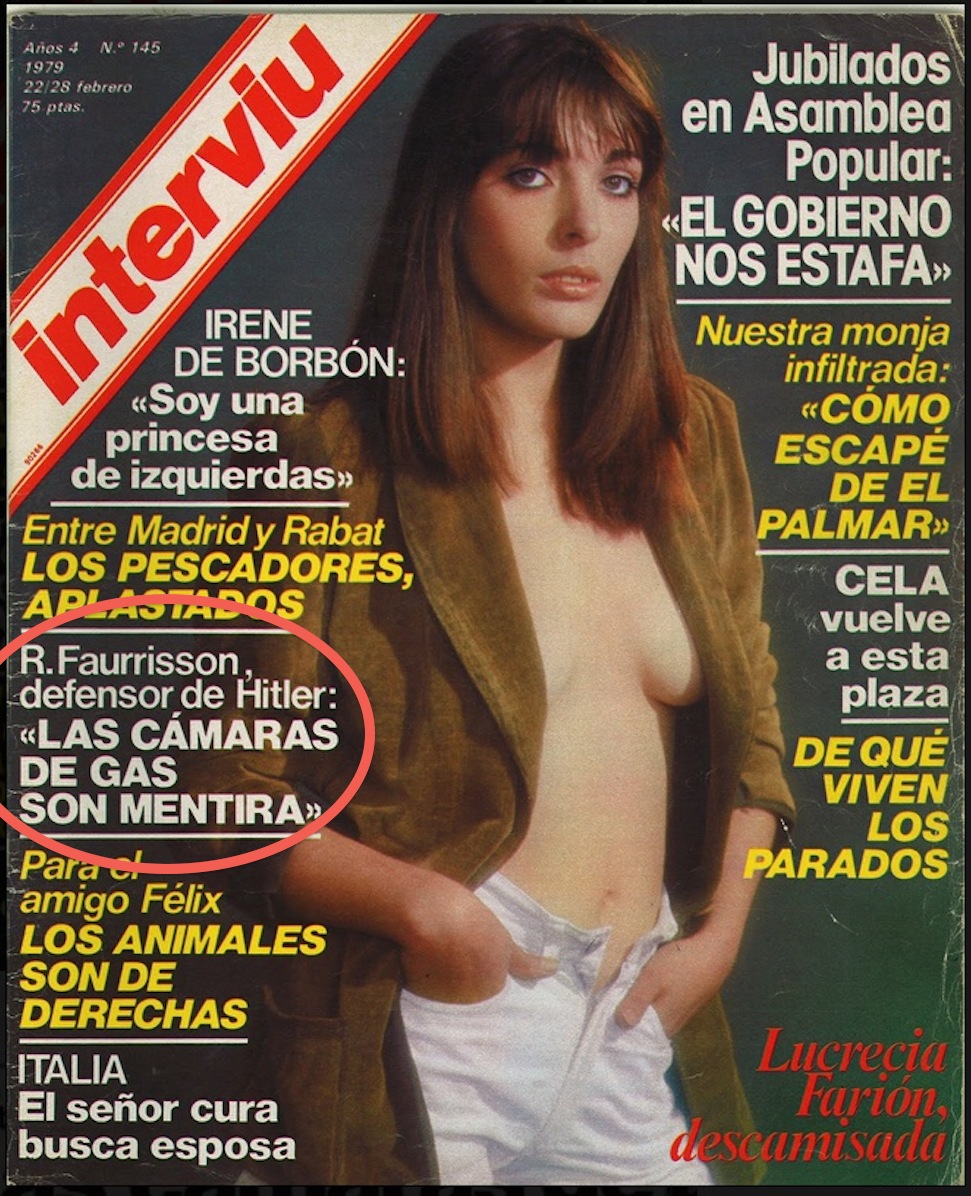
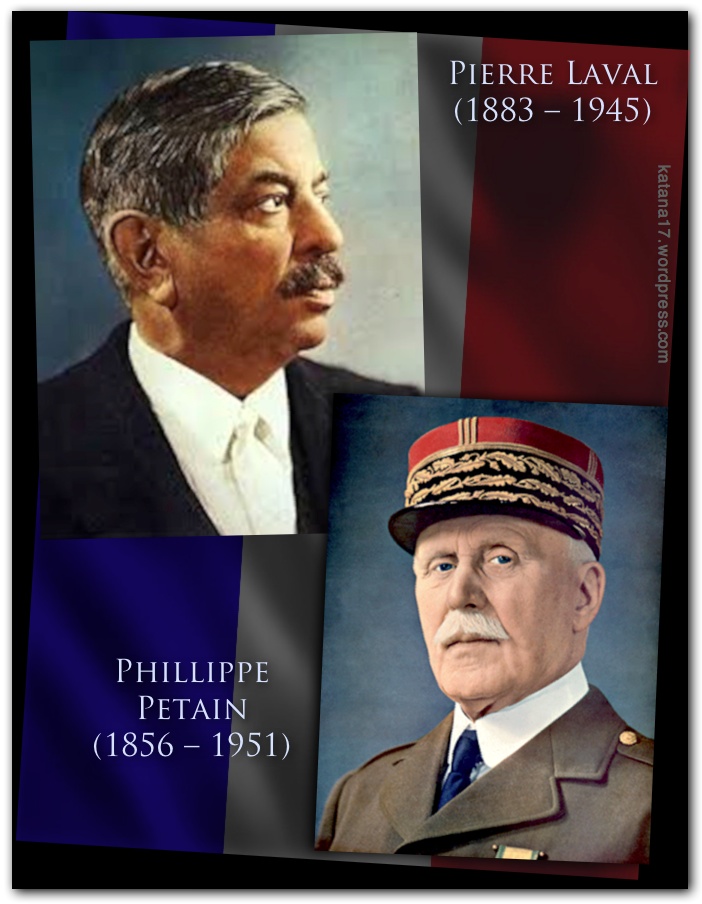


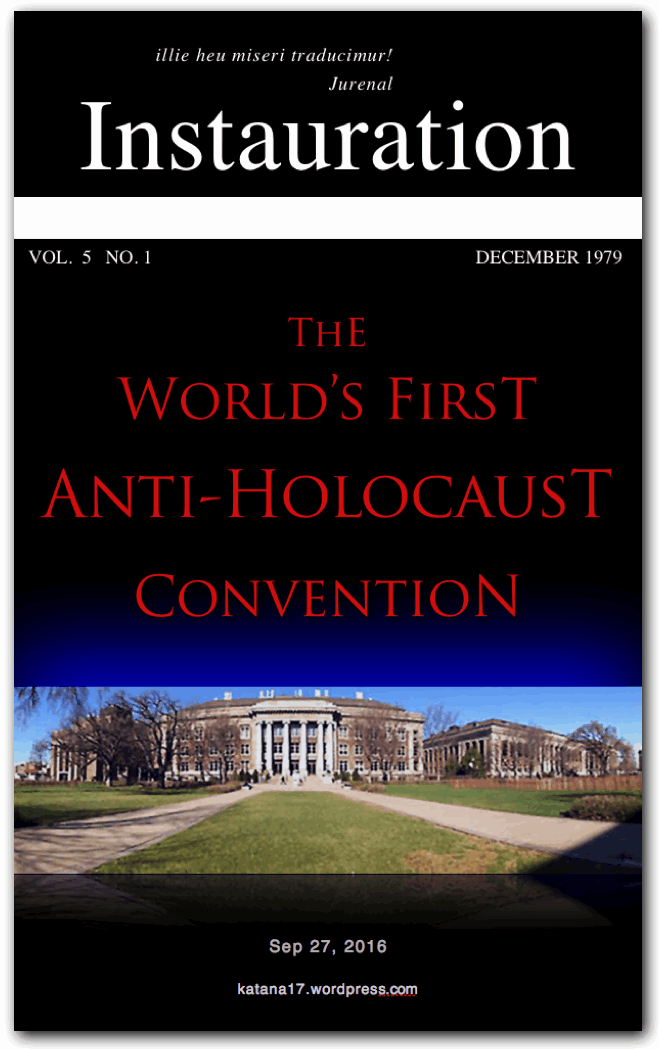
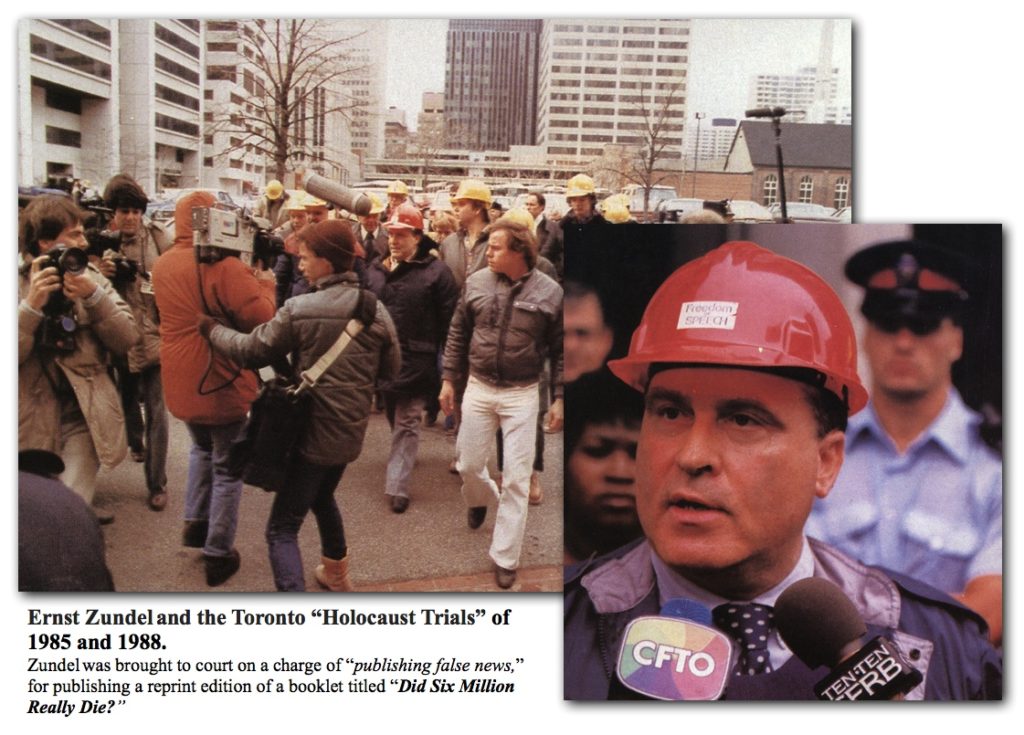
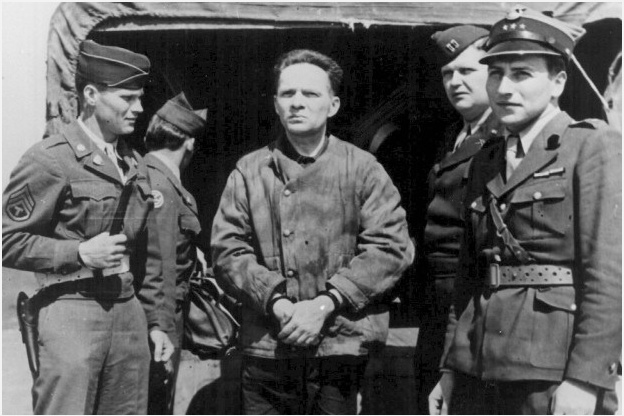
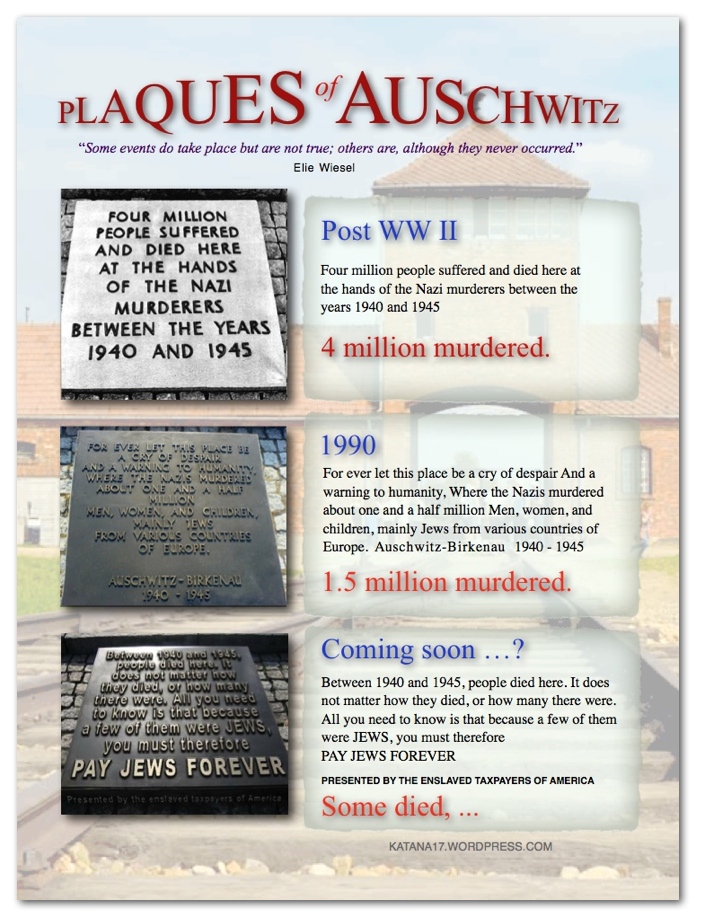
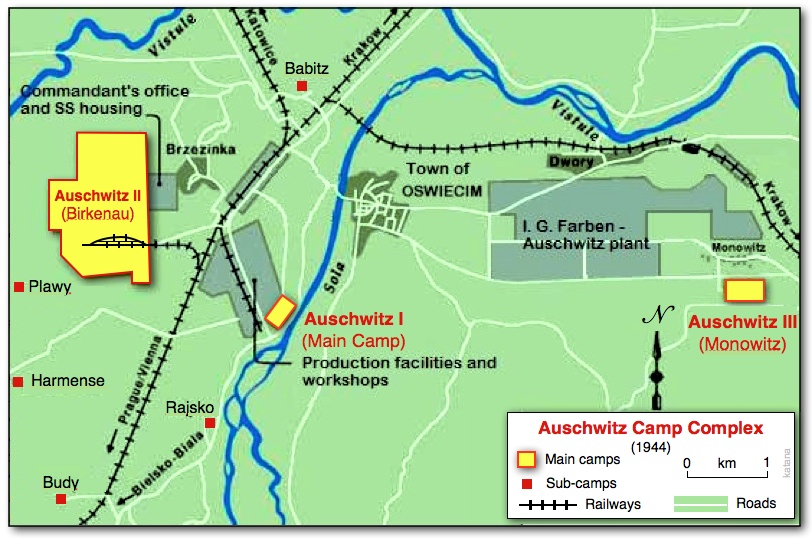
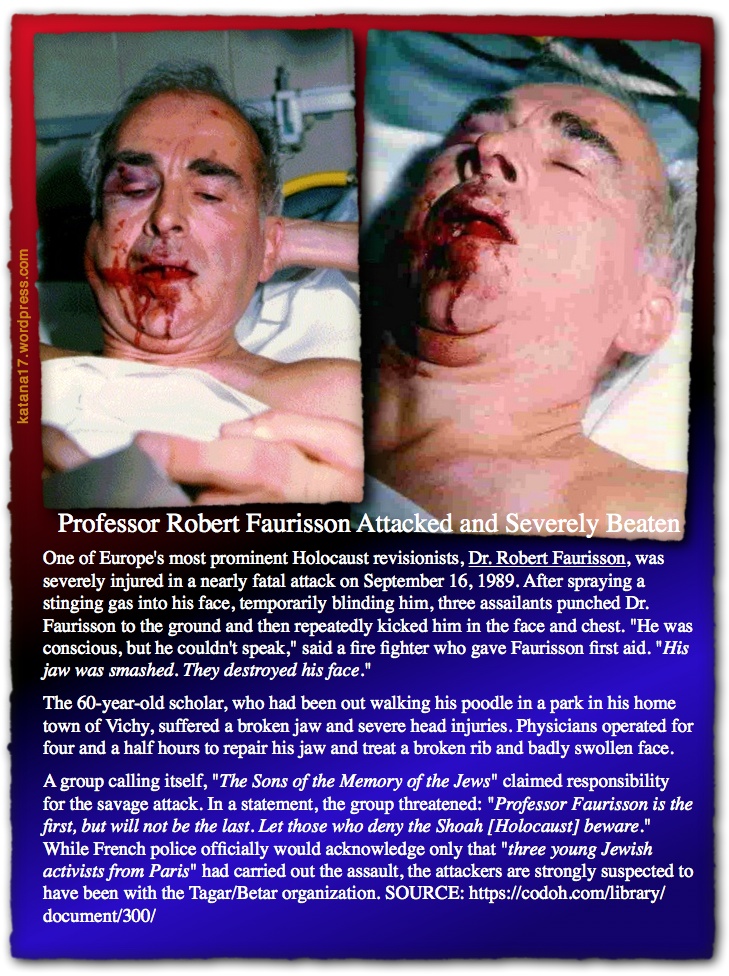
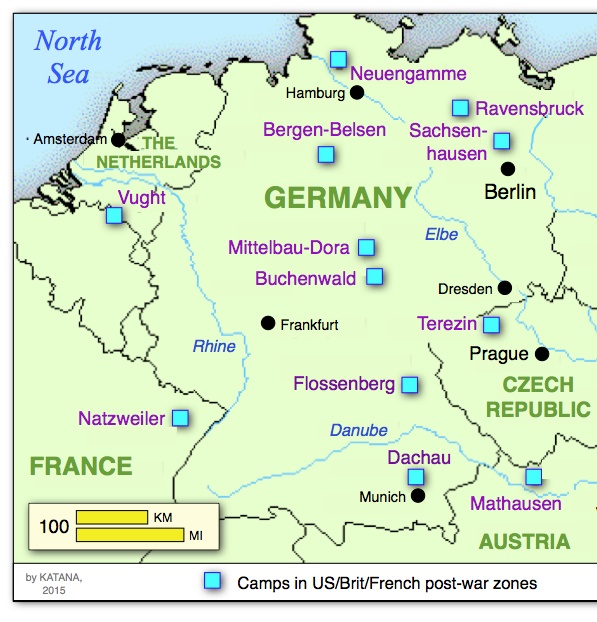

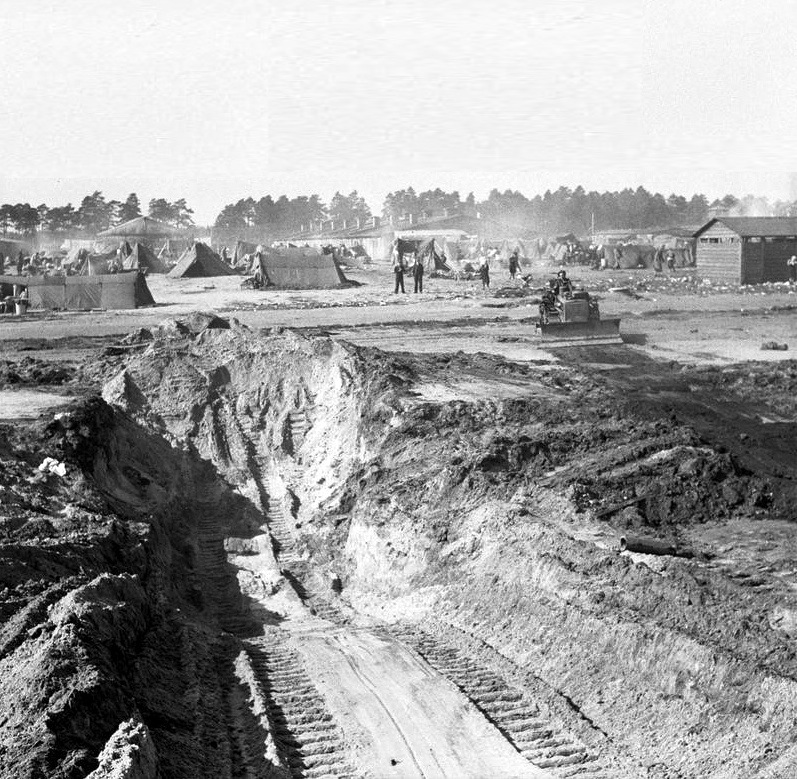
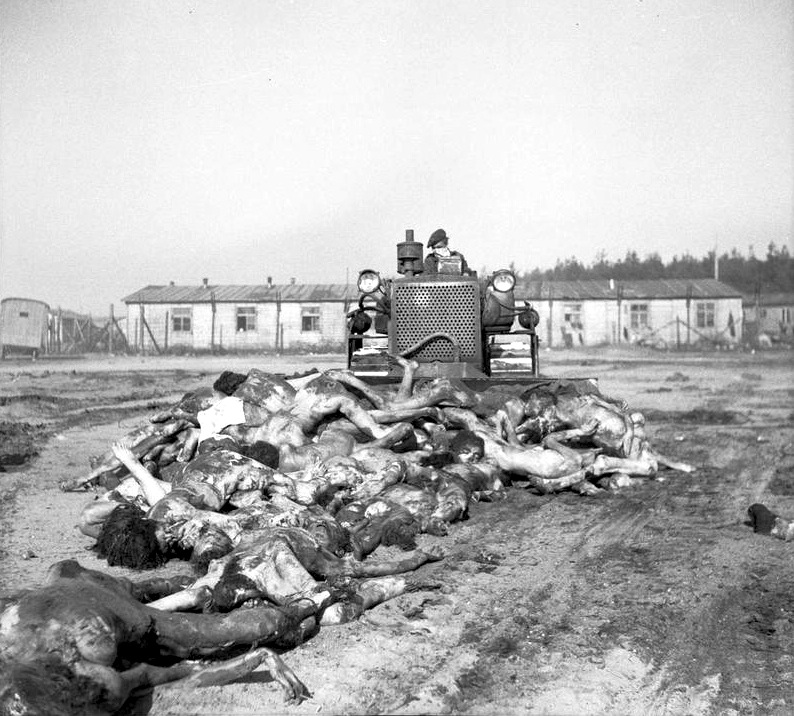
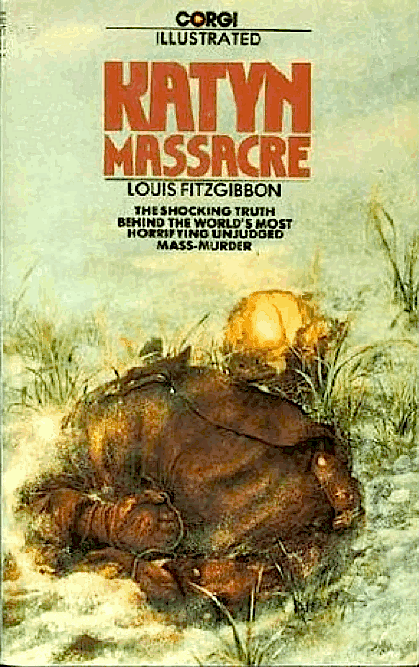
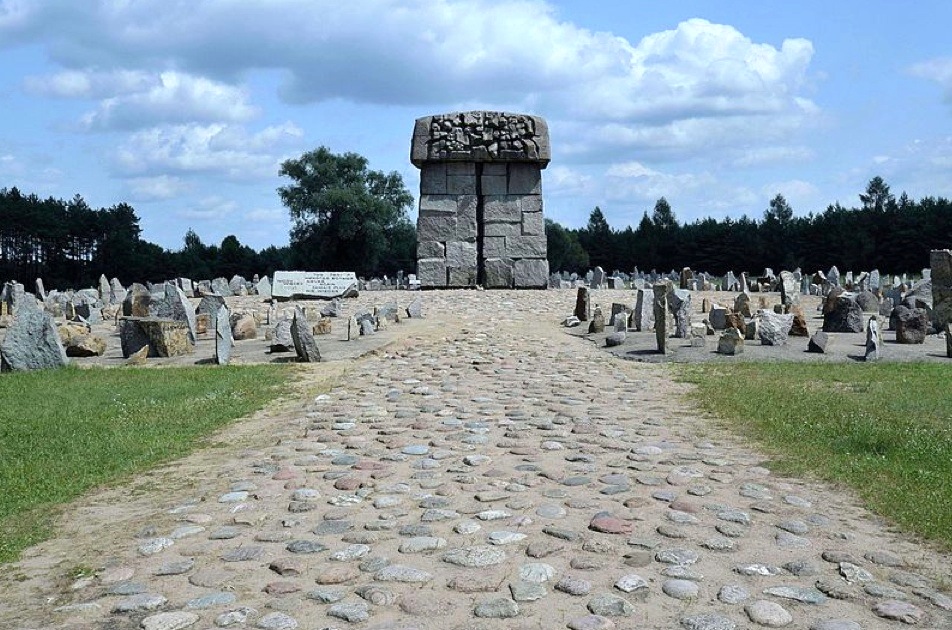
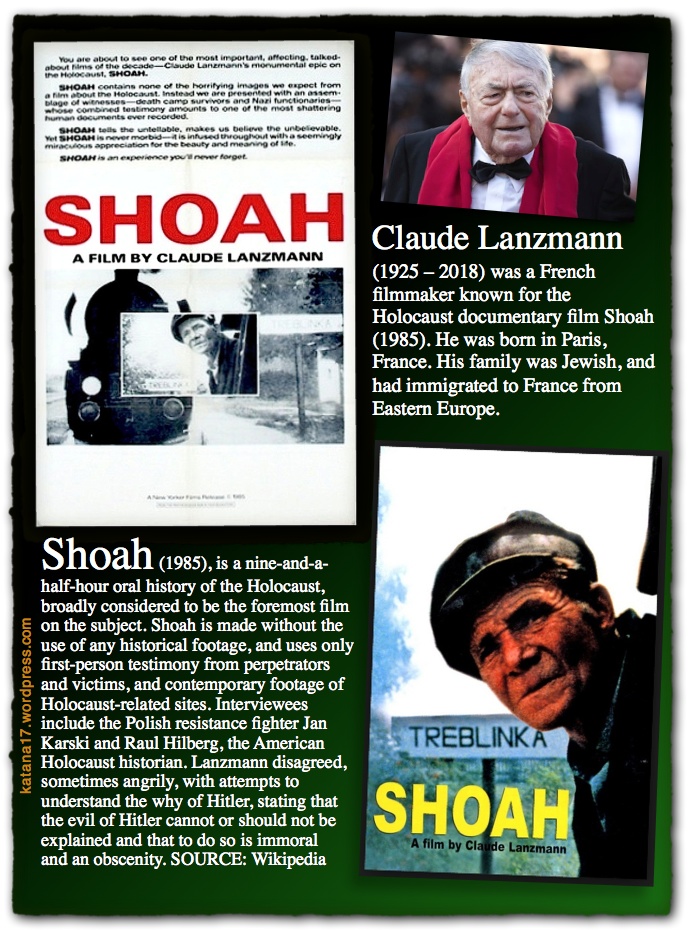

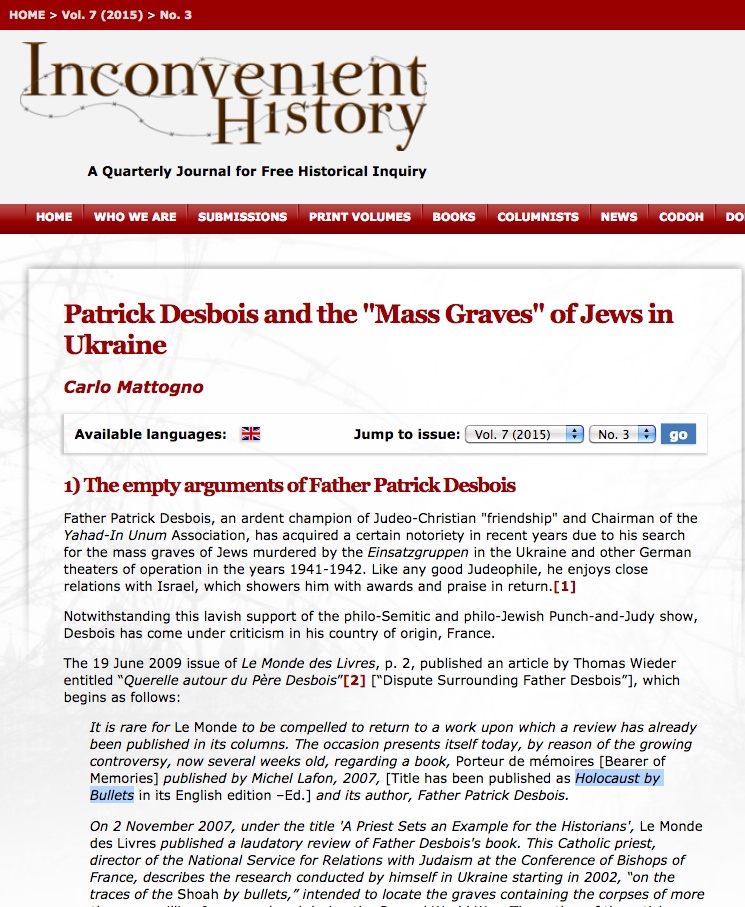
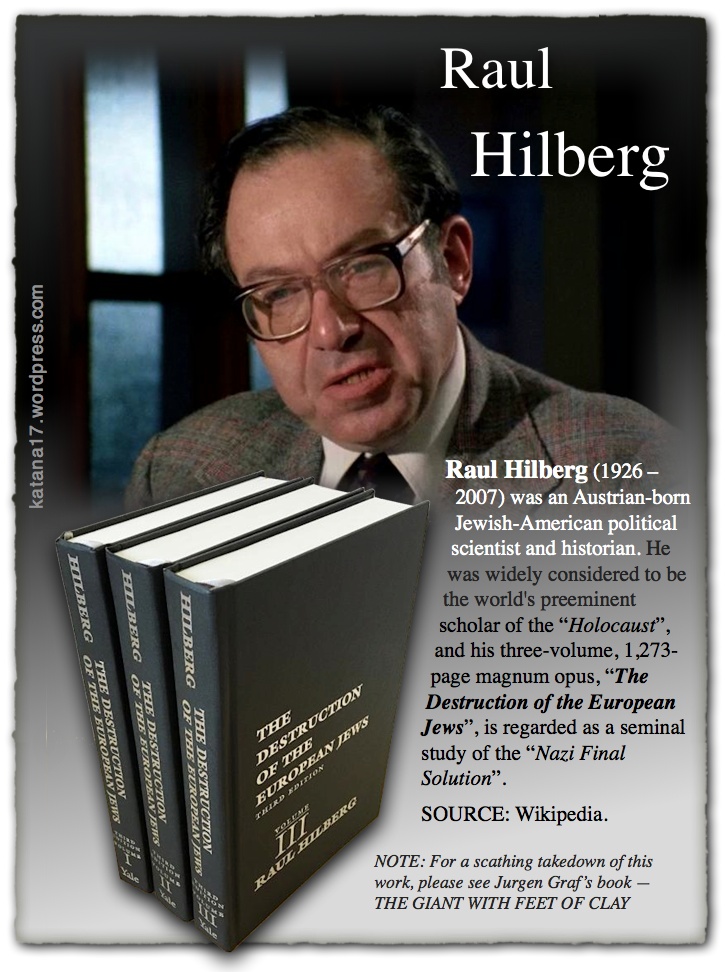

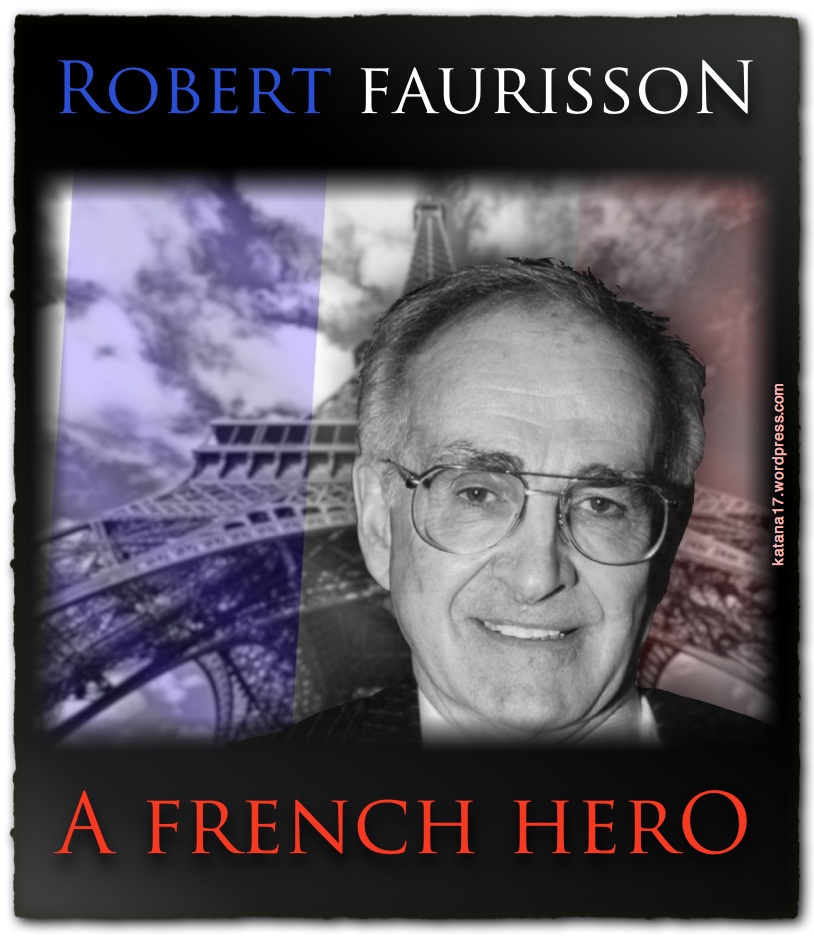

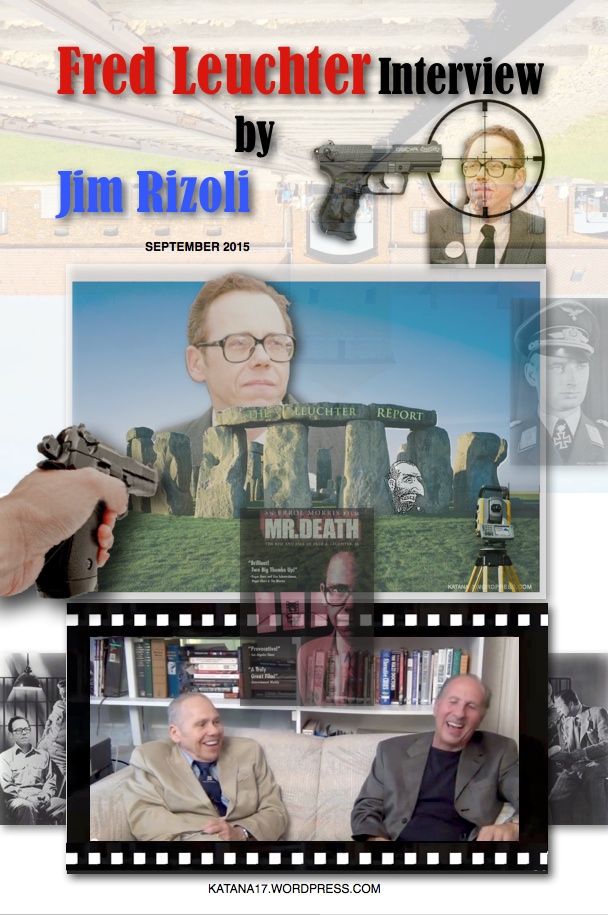

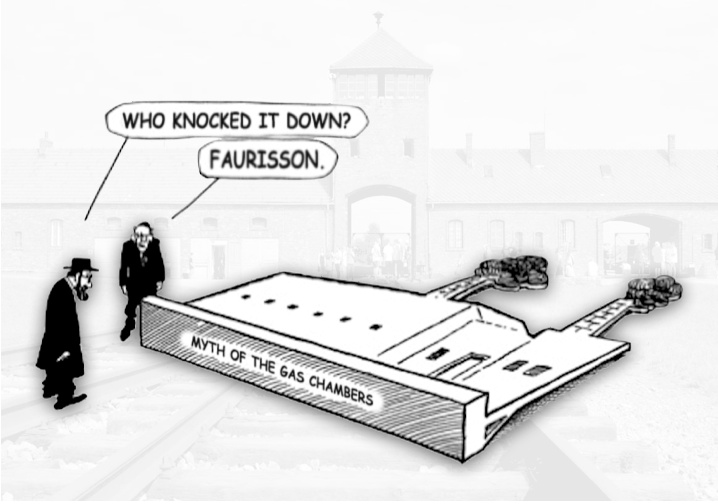
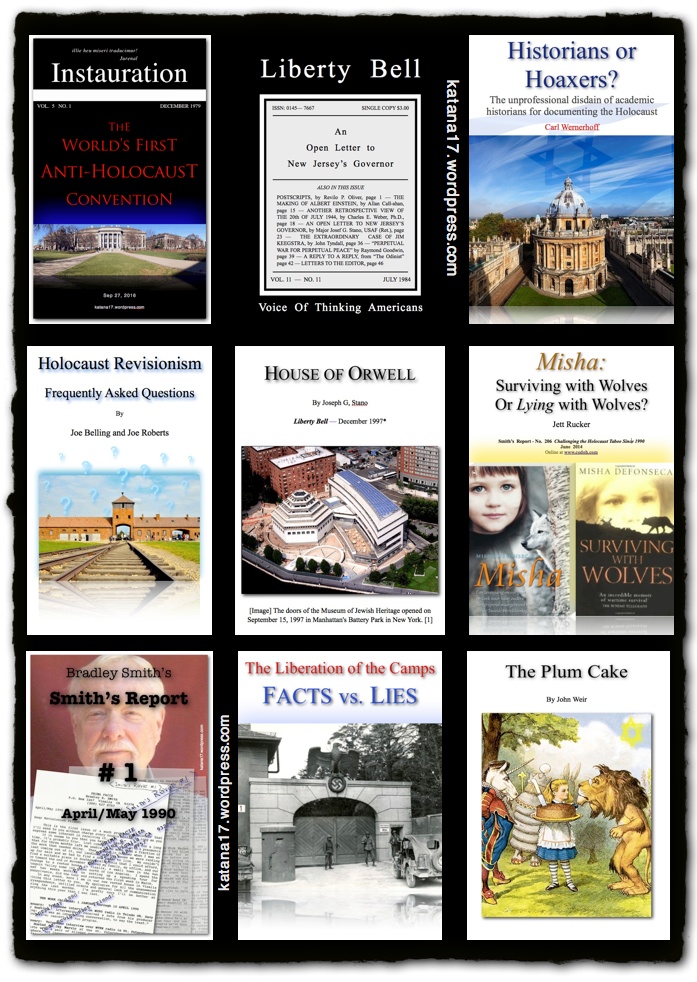
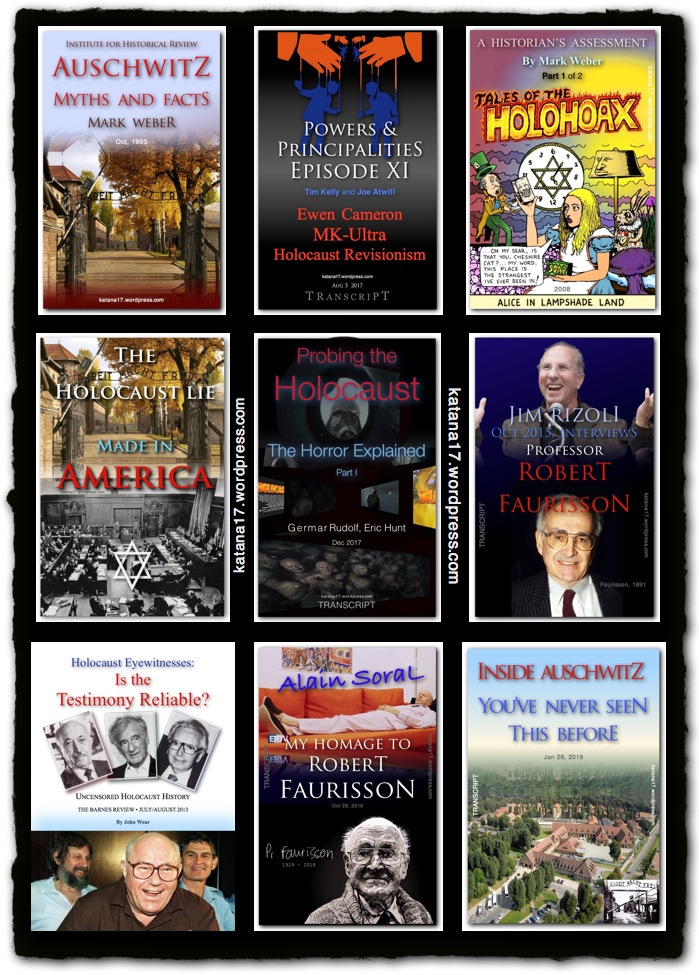
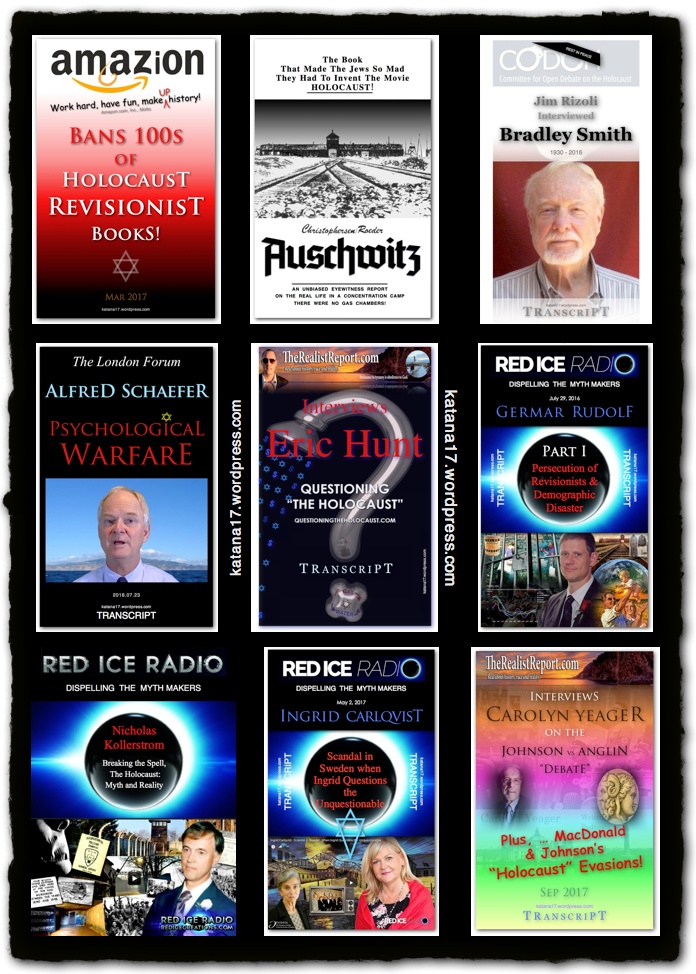
This clip has been blocked, but fortunately I downloaded it some time ago. Thanks. John Erasmus – South Africa.
Thanks John for the info. It’s also available on Bitchute:
https://www.bitchute.com/video/FbVcINOtox9k/
Want comedy? Here’s funny one: “Jews are Big Dicks with little weenies”, according to THEM.
https://www.bitchute.com/video/6IuxtB0bn9M2/
Pingback: Updates — Plain List - katana17katana17
Pingback: Inside Auschwitz - You've never seen THIS before! — TRANSCRIPT - katana17katana17
Pingback: Jim Rizoli Interviews Bradley Smith — TRANSCRIPT - katana17katana17
Pingback: London Forum - Alfred Schaefer - Psychological Warfare - TRANSCRIPT - katana17katana17
Pingback: The Realist Report Interviews Eric Hunt — TRANSCRIPT - katana17katana17
Pingback: Red Ice Radio - Germar Rudolf - Persecution of Revisionists & Demographic Disaster - Part 1— TRANSCRIPT - katana17katana17
Pingback: Jan 27 – Anniversary of Auschwitz "Liberation" and Our Enslavement - katana17katana17
Pingback: The Realist Report – John Friend with Germar Rudolf – Nov 5, 2020 — TRANSCRIPT - katana17katana17
Pingback: Jim Rizoli – Germar Rudolf – The Holocaust Handbooks and More – Jul 28, 2021 — Transcript | katana17
Pingback: The Flipside with Monika – Ep 2 – Jul 6, 2024 – Transcript | katana17